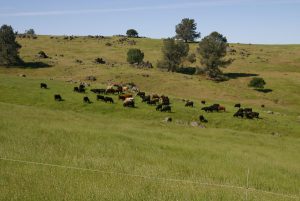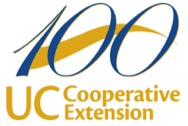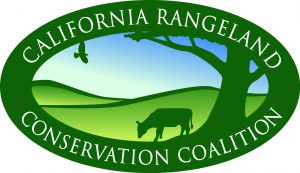Download fact sheet here
Background
California’s annual rangelands include open grasslands and woodlands dominated by an understory of herbaceous annual plants in the state’s valleys and low elevation mountains and foothills. These largely privately owned lands span 10 million acres and produce nearly 70% of the state’s livestock forage base. Therefore, annual rangelands provide a critical economic foundation for California’s rangeland livestock production1—annual gross value of cattle and sheep production exceeds $3 billion.
Through active stewardship and conservation, rangeland owners can manage for agricultural production and a diversity of other ecosystem services across these working landscapes. Managers can use prescribed grazing (the controlled implementation of timing, frequency, and intensity of grazing) as a tool to support and enhance multiple agricultural and conservation goals2—including biodiversity, wildlife habitat, and watershed health (Table 1).
Invasive Plant Management

Figure 1. Invasive weeds like medusahead are a major threat to California’s annual rangelands. Optimal timing of grazing for medusahead control is late spring, when plants are in the late vegetative to seed head emergence stages.
Large-scale weed invasion is a major threat to both conservation and agricultural goals on annual rangelands. Invasive weeds can significantly reduce rangeland health by inhibiting biodiversity, depressing forage productivity and quality for both livestock and wildlife, and depleting soil water resources3. Proper grazing management can maintain or enhance grassland diversity and productivity.
Prescribed grazing can be used to target specific weeds, particularly as part of a long-term integrated pest management program. The most critical components of a prescribed grazing program for weed management are timing and intensity of grazing. Target weeds must be grazed during their most biologically susceptible stages (Fig. 1). Using appropriate grazing timing and intensity can reduce undesirable weeds, such as medusahead and yellow starthistle, and increase desirable plants, such as forbs like clover, while maintaining production3.
Biodiversity and Habitat
Annual rangelands are one of the world’s major biodiversity hotspots, supporting thousands of plant and animal species. California’s rangelands provide habitat connectivity, which is critical for annual migration of many wildlife species. These lands also support important foraging and nesting habitat for wild pollinator populations, which provide crop pollination for many agricultural crops4. Loss of ranching as a land use can impact habitat connectivity and restructure the landscape matrix of ecosystems, often with negative consequences for native flora and fauna4.
Livestock grazing, via appropriate management strategies, can be used to maintain or enhance herbaceous plant diversity. Long-term studies have found that managed cattle grazing can be used as an effective tool to mitigate climate change and anthropogenic nitrogen deposition impacts on annual rangelands4. For example, grazing has been shown to enhance California’s unique vernal pool habitats by controlling exotic annual plants and enhancing herbaceous plant diversity, which can lead to longer pool inundation periods benefiting a diversity of aquatic species, including endangered species such as the California tiger salamander5.
| Ecosystem Services | Example Services from Annual Rangelands |
| Provisioning | Livestock production, Forage production, Water supply, Timber/Fuel wood production, Genetic resources |
| Regulating | Climate regulation, Water/Nutrient cycling, Pest control, Pollination, Moderation of extreme events, Resistance to weed invasion |
| Habitat | Plant and animal diversity, Migratory corridors, Genetic diversity |
| Cultural | Aesthetic, Recreation/tourism, Sense of place, Heritage |
Table 1. Examples of ecosystem services (the wide range of benefits humans obtain from the environment) provided by California’s annual rangelands.
Watershed Health
More than two-thirds of surface waters used for municipal and crop production in California are derived from rangeland watersheds. Microbial pollution from improperly managed livestock can threaten water quality. Fortunately, researchers and managers have widely demonstrated that prescribed grazing management—used in concert with the natural capacity of rangelands to mitigate microbial pollutants—provides for clean water6-8. Recent scientific literature syntheses have documented a large tool box of effective rangeland and livestock management options that minimize risks of direct deposition or hydrologic transport of viable microbial pollutants from cattle fecal material to surface waterbodies of concern2,9. These collective findings have been integrated into educational materials supporting on-ranch water quality protection10.
Key Points
- California’s annual rangelands span approximately 10 million acres.
- Annual rangelands support cattle production, the state’s 4th most valued commodity, and the 2nd largest sheep herd in the US.
- Managers can use prescribed grazing to support and enhance agricultural and conservation goals, including production and biodiversity.
- California rangelands provide habitat connectivity, which is critical for the migration of many species.
- Proper grazing management maintains rangelands’ capacity to attenuate waterborne pollutants and supply clean water.
Further Reading
- Roche, L et al. 2015. Sustaining working rangelands: insights from rancher decision making. Range Ecol Manage. 68:383-9.
- Briske, DD (ed). 2011. Conservation Benefits of Rangeland Practices: Assessment, Recommendations, and Knowledge Gaps. Lawrence, KS: Allen Press.
- DiTomaso JM. Invasive weeds in rangelands: Species, impacts, and management. Weed Sci. 2000. 48:255-65.
- Huntsinger, L and JL Oviedo. 2014. Ecosystem services are social-ecological services in a traditional pastoral system: the case of California’s Mediterranean rangelands. Ecol and Soc 19 (1): 8.
- Pyke, C and J Marty. 2005. Cattle grazing mediates climate change impacts on ephemeral wetlands. Cons Biol 19:1619-1625.
- Roche, L et al. 2013. Water quality conditions associated with cattle grazing and recreation on national forest lands. PLOS ONE 8(6): e68127.
- Li, X et al. 2005. Seasonal temperature fluctuation induces rapid inactivation of Cryptosporidium parvum. Env Sci Tech. 39:4484-4489.
- Tate, KW et al. 2006. Significant E. coli attenuation by vegetative buffers on annual grasslands. J. Env Q. 35:795-805.
- Atwill, ER et al. 2012. Introduction to waterborne pathogens in agricultural watersheds. USDA NRCS. Tech Note No. 9. 90 pp.
- George, MR et al. 2011. California’s rangeland water quality management plan: an update. Rangelands. 33:20-24.



